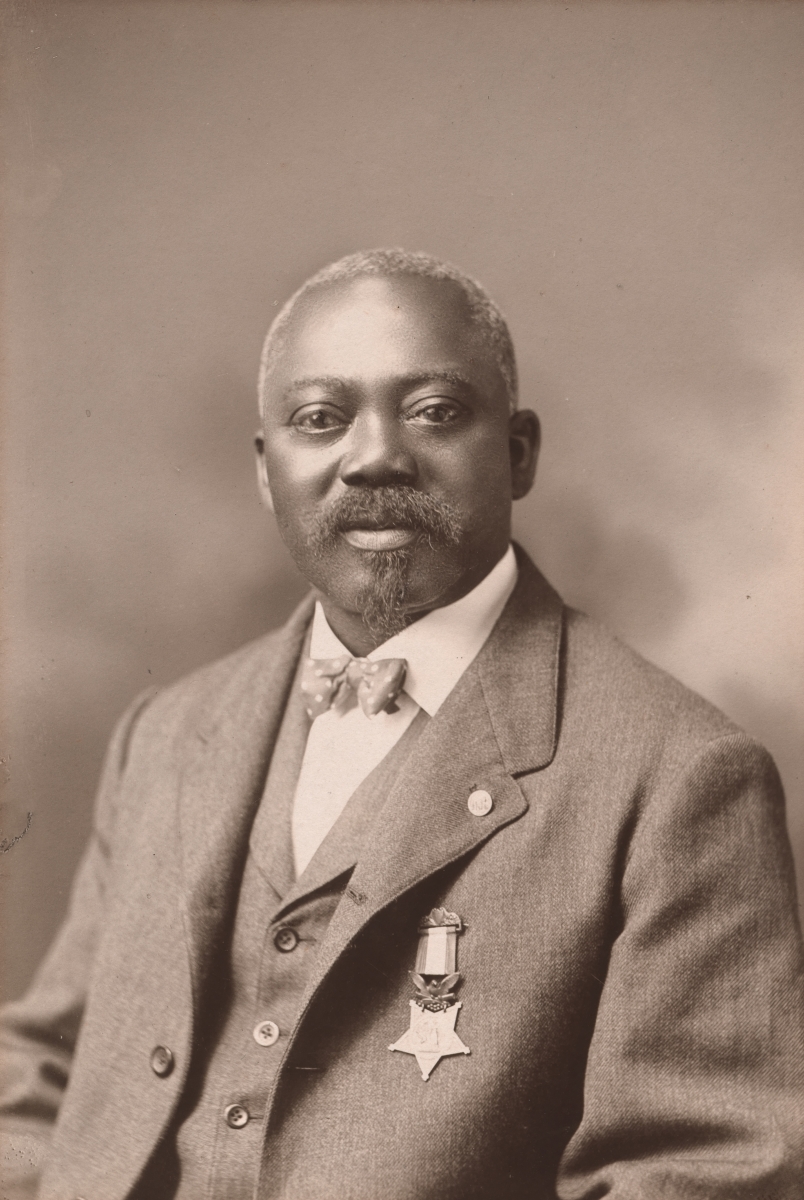Sgt. William H. Carney
Born in 1840 to a slave mother in Norfolk, Virginia, who was later freed upon her owner’s death in 1854, William H. Carney eventually settled in New Bedford, Massachusetts and prepared himself to enter the ministry. 8 In 1863 the Union Army began to organize colored units, and one of the first was the 54th Massachusetts Infantry, organized at Camp Meigs. Carney was one of 47 African Americans recruited from New Bedford. Carney joined up and was assigned to Company C. In an 1863 interview for the Liberator magazine Carney explained his reasons for joining:
“Previous to the formation of colored troops, I had a strong inclination to prepare myself for the ministry; but when the country called for all persons, I could best serve my God serving my country and my oppressed brothers. The sequel is short — I enlisted for the war.”
The 54th, along with the 1st North Carolina Colored Volunteers (redesignated the 35th United States Colored Troops (USCT) in 1864) were the object of great interest and curiosity, and their performance would be considered an important indication of the possibilities of using former black slaves in war. 10 The 54th largely consisted of freedmen, primarily from Pennsylvania and Massachusetts, and the 1st was made up of ex-slaves from the coastal areas of Virginia and the Carolinas.

Though late to the war, the 54th soon saw action at James Island in June 1863. But it was on July 18, 1863, that Carney would distinguish himself and cause his Regiment to be widely known. While leading the attack on Fort Wagner, South Carolina, the 54th was repulsed and Regimental commander Col. Robert G. Shaw was mortally wounded. In this desperate attack, the 54th was placed in the lead and 281 men of the regiment became casualties (54 were killed or fatally wounded and another 48 were never accounted for). Shaw died on the crest of the enemy parapet, shouting, “Forward, Fifty-fourth!”
According to Carney’s Medal of Honor citation:
“When the color sergeant was shot down, this soldier [Carney] grasped the flag, led the way to the parapet, and planted the colors thereon. When the troops fell back he brought off the flag, under a fierce fire in which he was twice severely wounded.”
As Carney handed the flag over to other survivors of the 54th, he told them, “Boys, I only did my duty. The old flag never touched the ground.” Those words inspired a 1901 song by Bob Cole, James Weldon Johnson, and J. Rosamond Johnson commemorating Carney’s heroism titled “The Old Flag Never Touched the Ground.” The bravery of Carney was duly recognized in his being awarded the Medal of Honor, the first ever conferred to an African-American. However it was not presented to Carney until May 20 1900. After leaving the service in 1865, Carney eventually returned to Massachusetts where he worked as a mail carrier in New Bedford. He died in 1908. Today, the flag he saved is preserved in Boston’s Memorial Hall and Carney’s home is known as the Sergeant Carney Memorial House.
CARNEY, WILLIAM H.
- Rank and organization: Sergeant, Company C, 54th Massachusetts Colored Infantry
- Place and date: At Fort Wagner, S.C., 18 July 1863
- Entered service at: New Bedford, Mass.
- Date of issue: 23 May 1900
Citation: When the color sergeant was shot down, this soldier grasped the flag, led the way to the parapet, and planted the colors thereon. When the troops fell back he brought off the flag, under a fierce fire in which he was twice severely wounded.

You must be logged in to post a comment.